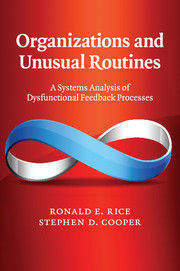Book contents
- Frontmatter
- Contents
- List of figures
- List of tables
- List of boxes
- Preface
- Acknowledgments
- 1 Crazy systems, Kafka circuits, and unusual routines
- 2 Causes, symptoms, and subroutines of unusual routines in six computer information/communication systems
- 3 Getting personal: unusual routines at the customer service interface
- 4 A multi-theoretical foundation for understanding unusual routines
- 5 A detailed case study of unusual routines
- 6 Summary and discussion of the case study results
- 7 Individual and organizational challenges to feedback
- 8 A multi-level and cross-disciplinary summary of concepts related to unusual routines
- 9 Recommendations for resolving and mitigating unusual routines and related phenomena
- 10 Summary and a tentative integrated model of unusual routines
- References
- Index
6 - Summary and discussion of the case study results
Published online by Cambridge University Press: 10 January 2011
- Frontmatter
- Contents
- List of figures
- List of tables
- List of boxes
- Preface
- Acknowledgments
- 1 Crazy systems, Kafka circuits, and unusual routines
- 2 Causes, symptoms, and subroutines of unusual routines in six computer information/communication systems
- 3 Getting personal: unusual routines at the customer service interface
- 4 A multi-theoretical foundation for understanding unusual routines
- 5 A detailed case study of unusual routines
- 6 Summary and discussion of the case study results
- 7 Individual and organizational challenges to feedback
- 8 A multi-level and cross-disciplinary summary of concepts related to unusual routines
- 9 Recommendations for resolving and mitigating unusual routines and related phenomena
- 10 Summary and a tentative integrated model of unusual routines
- References
- Index
Summary
This chapter extends the discussion of the propositions to more general properties of unusual routines within complex organizations. Each proposition is represented by just one or two of the salient examples from the full case. The chapter concludes with a substantially reworked model of UR dynamics, indicating what we see as the relationships among innovations, organizational culture, and URs.
Proposition One
If a new ICT mitigates or exacerbates URs it does so not simply as a more efficient channel (the first-level effect) but also as an innovation the organization must process (the second-level effect).
The interviews revealed a number of URs with associated subroutines, some of which the system implementation seemed to be impacting as a second-level effect. Perhaps the change in the grading system is the clearest example. Arguably, the past debates over the grading system can be seen as a delay subroutine, in that the issue was never decisively resolved either in favor of retaining the existing non-traditional grades or in favor of a change, despite extensive discussion time spent on the issue. To some informants, the grading system had become a “sacred cow,” resistant to change regardless of substantial criticism. While the new ICT was still in its early implementation phase at the time of these interviews, a major change in the grading system was made in a surprisingly short time frame. A number of informants saw the ICT as a contributing factor in this change.
- Type
- Chapter
- Information
- Organizations and Unusual RoutinesA Systems Analysis of Dysfunctional Feedback Processes, pp. 200 - 216Publisher: Cambridge University PressPrint publication year: 2010



